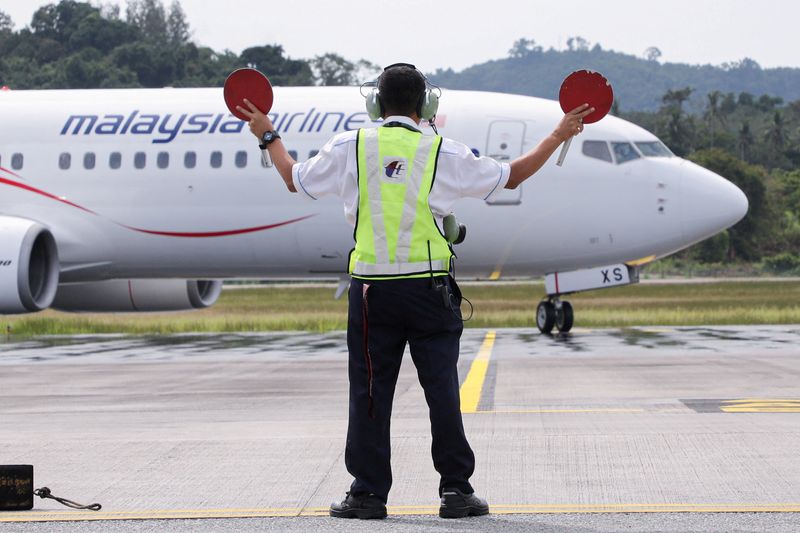(Reuters) - The price of oil this week surged to its highest point since 2008 after Russia's invasion of Ukraine, adding to airline costs at a time when carriers have been struggling to recover from a pandemic-related collapse in demand.
Oil prices were already strong because of tight global supplies, but Western sanctions on Russia, a major oil supplier, over its invasion of Ukraine, sent prices into overdrive. The northwest European jet fuel price in the spot market soared by 85% since Feb. 25 to $1,649 a tonne on Wednesday, though it fell back to $1,007 by Friday.
Malaysia Airlines said on Friday it would put in place a fuel surcharge for some markets from March 23 and manage capacity to mitigate unprofitable routes due to rising fuel costs.
Its budget rival AirAsia on March 5 introduced fuel surcharges on tickets for the first time since 2015. Chinese airlines, meanwhile, raised fuel surcharges on domestic routes and Emirates, Japan Airlines and ANA Holdings have also raised surcharges recently.
Some airlines have oil hedges that will help partially offset the price increase, but other carriers are fully unhedged, including U.S. majors United Airlines, American Airlines (NASDAQ:AAL) and Delta Air Lines (NYSE:DAL), though the latter does own an oil refinery.
Many carriers are also being squeezed by the need to fly longer routes to avoid Russian and Ukrainian airspace.
Air France KLM
The airline has hedged 72% of oil consumption for the first quarter and 63% for the second quarter at $90 a barrel, with smaller amounts hedged in the second half, it said in a results presentation on Feb. 17.
Air New Zealand
The airline has hedged 1.34 million barrels of oil in the six months to June 30 and 707,500 barrels in the following half-year period, it said in a results presentation on Feb. 24. In late February it raised international fares by about 5%, citing rising oil prices and general cost inflation.
Cathay Pacific Airways
The Hong Kong airline has hedged its entire first-quarter consumption and about half of its expected second-quarter consumption, it said on Wednesday. It has also hedged lower amounts through the end of 2023.
easyJet (LON:EZJ)
The European airline 60% hedged for fuel in the financial year to Sept. 30 at about $504 per metric tonne, it said on Jan. 27.
IAG (LON:ICAG)
The British Airways owner is hedged against volatile crude prices for two years, Chief Executive Luis Gallego said on Feb. 25. It has covered about 60% for the whole of 2022.
Based on a fuel price scenario of $900 a tonne, the company would be paying $690 a tonne in the first quarter after hedging 70% of its fuel and foreign exchange, a Feb. 25 results presentation shows. In the second quarter the price would rise to $750 after hedging 65% of fuel and foreign exchange.
Lufthansa
The German airline is 63% hedged in 2022 at a break-even price of $74 a barrel, it said in a results presentation on March 3.
Qantas Airways
The Australian airline has more than 90% of its fuel hedged for the six months to June 30, Chief Executive Alan Joyce said on Tuesday, adding it had also hedged 50% of its fuel for the following quarter.
Ryanair (NASDAQ:RYAAY)
The budget carrier is 80% hedged on fuel out to 2023, but rising prices will still cost the group about 50 million euros ($54.2 million) over the next 12 months, Chief Executive Michael O'Leary said on March 2, adding that Ryanair would not introduce fuel charges for the summer.
Singapore Airlines
The airline hedged 30% of its oil needs at an average Brent crude price of $57 a barrel for the six months to March 31, it said in a results presentation in November. It had also hedged 40% of its needs at an average price of $60 for the following five quarters.
Wizz Air
The European budget airline on Monday said it has covered its fuel costs for the next four months with zero-cost hedges.

For March, it has covered half its needs with a price ceiling of $1,172 a tonne and 40% of its needs for the first quarter to end-June at $1,142 a tonne. Its financial year ends on March 31, 2023.
($1 = 0.9223 euros)